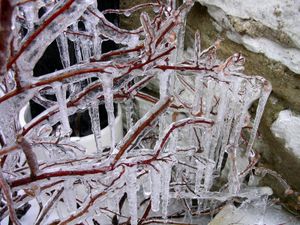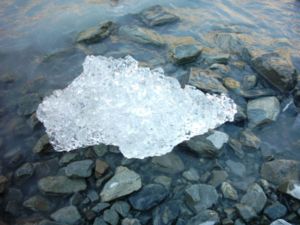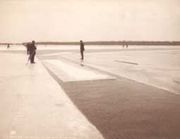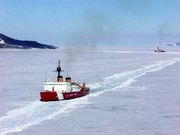Ice
2007 Schools Wikipedia Selection. Related subjects: Chemical compounds; General Physics
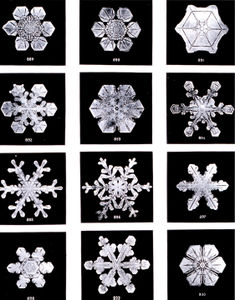
Ice is an Oxide class mineral that is referred to by any one of the 14 known solid phases of water. However, in non-scientific contexts, it usually describes ice Ih, which is the most abundant of these phases in Earth's biosphere. This type of ice is a soft, delicate, crystalline solid, which can appear transparent or an opaque bluish-white colour depending on the presence of impurities such as air. The addition of other materials such as soil may further alter appearance. The most common phase transition to ice Ih occurs when liquid water is cooled below 0 °C (273.15 K, 32 °F) at standard atmospheric pressure. However, it can also deposit from a vapor with no intervening liquid phase such as in the formation of frost. Ice appears in varied forms such as hail, ice cubes, and glaciers. It plays an important role with many meteorological phenomena. The ice caps of the polar regions are of significance for the global climate and particularly the water cycle.
Characteristics
An unusual feature of ice frozen at a pressure of one atmosphere is that the solid is some 8% less dense than liquid water. Water is also one of the few substances to expand when it freezes. Ice has a density of 0.917 g/cm³ at 0 °C, whereas water has a density of 0.9998 g/cm³ at the same temperature. Liquid water is most dense, essentially 1.00 g/cm³, at 4 °C and becomes less dense as the water molecules begin to form the hexagonal crystals of ice as the temperature drops to 0 °C. (In fact, the word "crystal" derives from Greek word for frost.) This is due to hydrogen bonds forming between the water molecules, which line up molecules less efficiently (in terms of volume) when water is frozen. The result of this is that ice floats on liquid water, an important factor in Earth's climate. Density of ice increases slightly with decreasing temperature (density of ice at −180 °C (93 K) is 0.9340 g/cm³).
When ice melts, it absorbs as much heat energy (the heat of fusion) as it would take to heat an equivalent mass of water by 80 °C, while its temperature remains a constant 0 °C.
It is also theoretically possible to superheat ice beyond its equilibrium melting point. Simulations of ultrafast laser pulses acting on ice shows it can be heated up to room temperature for an extremely short period (250 ps) without melting it. It is possible that the interior of an ice crystal has a melting point above 0 °C and that the normal melting at 0 °C is just a surface effect.
As a naturally occurring crystalline solid, ice is considered a mineral.
The smallest ice was created by Roger Miller and Klaus Nauta in the University of North Carolina in 1999. It is 6 water molecules arranged in a hexagon, theoretically the smallest ice possible.
Types of ice
Everyday ice and snow is hexagonal ice ( ice Ih). Subjected to higher pressures and varying temperatures, ice can form in roughly a dozen different phases. Only a little less stable (metastable) than Ih is cubic structure ice ( Ic). Cooling Ih causes a different arrangement to form in which the protons move, XI.
With both cooling and pressure more types exist, each being created depending on the phase diagram of ice. These are II, III, V, VI, VII, VIII, IX, and X. With care all these types can be recovered at ambient pressure. The types are differentiated by their crystalline structure, ordering and density. There are also two metastable phases of ice under pressure, both fully hydrogen disordered, these are IV and XII. Ice XII was discovered in 1996. As well as crystalline forms solid water can exist in amorphous states as amorphous solid water (ASW), low density amorphous ice (LDA), high density amorphous ice (HDA), very high density amorphous ice (VHDA) and hyperquenched glassy water (HGW).
Rime is a type of ice formed on cold objects when the humidity in the air crystalizes on them. This can be observed in foggy weather or when the temperature drops during night. It contains a high proportion of trapped air, making it appear white rather than transparent, and giving it a density about one quarter of that of pure ice.
Aufeis is layered ice that forms in arctic and subarctic stream valleys. Ice frozen in the stream bed blocks normal groundwater discharge and causes the local water table to rise, resulting in water discharge on top of the frozen layer. This water then freezes, causing the water table to rise further and repeat the cycle. The result is a stratified ice deposit, often several meters thick.
Ice can also form icicles, similar to stalactites in appearance, as water drips and re-freezes.
Clathrate hydrates are forms of ice that contain gas molecules trapped within its crystal lattice. Pancake ice is a formation of ice generally created in areas with less calm conditions.
Some other substances (particularly solid forms of those usually found as fluids) are also called "ice": dry ice, for instance, is a popular term for solid carbon dioxide.
In outer space hexagonal crystalline ice, the predominant form on Earth, is extremely rare. Amorphous ice is more common; however, hexagonal crystalline ice can be formed via volcanic action.
Uses of ice
Ice harvesting
Ice has long been valued as a means of cooling. Until recently, the Hungarian Parliament building used ice harvested in the winter from Lake Balaton for air conditioning. Icehouses were used to store ice formed in the winter to make ice available year-round, and early refrigerators were known as iceboxes because they had a block of ice in them. In many cities it was not unusual to have a regular ice delivery service during the summer. For the first half of the 19th century, ice harvesting had become big business in America. New Englander Frederic Tudor, who became known as the “Ice King,” worked on developing better insulation products for the long distance shipment of ice, especially to the tropics. The advent of artificial refrigeration technology has since made delivery of ice obsolete.
In 400 BC Iran, Persian engineers had already mastered the technique of storing ice in the middle of summer in the desert. The ice was brought in during the winters from nearby mountains in bulk amounts, and stored in specially designed, naturally cooled refrigerators, called yakhchal (meaning ice storage). This was a large underground space (up to 5000 m³) that had thick walls (at least two meters at the base) made out of a special mortar called sārooj, composed of sand, clay, egg whites, lime, goat hair, and ash in specific proportions, and which was resistant to heat transfer. This mixture was thought to be completely water impenetrable. The space often had access to a Qanat, and often contained a system of windcatchers that could easily bring temperatures inside the space down to frigid levels in summer days. The ice was then used to chill treats for royalty during hot summer days.
Sports on ice
Ice also plays a role in winter recreation, in sports such as ice skating, tour skating, ice hockey, ice fishing, ice climbing, curling and sled racing on bobsled, luge and skeleton. A sort of sailboat on blades gives rise to iceboating.
The human quest for excitement has even led to ice racing, where drivers must speed on lake ice while also controlling the skid of their vehicle (similar in some ways to dirt track racing). The sport has even been modified for ice rinks.
Ice travel
Ice can also be an obstacle; for harbors near the poles, being ice-free is an important advantage, ideally all-year round. Examples are Murmansk (Russia), Petsamo (Russia, formerly Finland) and Vardø (Norway). Harbors that are not ice-free are opened up using icebreakers.
Ice forming on roads is a dangerous winter hazard. Black ice is very difficult to see because it lacks the expected glossy surface. Whenever there is freezing rain or snow that occurs at a temperature near the melting point, it is common for ice to build up on the windows of vehicles. Driving safely requires the removal of the ice build-up. Ice scrapers are tools designed to break the ice free and clear the windows, though removing the ice can be a long and labor-intensive.
Far enough below the freezing point, a thin layer of ice crystals can form on the inside surface of windows. This usually happens when a vehicle has been left alone after being driven for a while, but can happen while driving if the outside temperature is low enough. Moisture from the driver's breath is the source of water for the crystals. It is troublesome to remove this form of ice, so people often open their windows slightly when the vehicle is parked in order to let the moisture dissipate, and it is now common for cars to have rear-window defrosters to combat the problem. A similar problem can happen in homes, which is one reason why many colder regions require double-pane windows for insulation.
When the outdoor temperature stays below freezing for extended periods, very thick layers of ice can form on lakes and other bodies of water (although places with flowing water require much colder temperatures). The ice can become thick enough to drive onto with automobiles and trucks. Doing this safely requires a thickness of at least 30 centimeters (one foot).
Other uses of ice
- The manufacture and use of ice cubes or crushed ice is common for drinks.
- Pagophagia, a type of pica eating disorder, is the compulsive consumption of ice.
- Structures and ice sculptures are built out of large chunks of ice. The structures are mostly ornamental (as in the case with ice castles) and not practical for long-term habitation. Ice hotels exist on a seasonal basis in a few cold areas. Igloos are another example of a temporary structure, made primarily from snow.
- It is possible to stab someone to death with an icicle. This can confound investigators, as once the icicle melts there will be no apparent murder weapon. A large lump of ice can be used to inflict blunt force trauma in a similar vein.
- During World War II, Project Habbakuk was a British program which investiagted the use of pykrete (wood fibres mixed with ice) as a possible material for warships, especially aircraft carriers due to the ease with which a large deck could be constructed, but the idea was given up when there was not enough funds for construction of a prototype.
Ice at different pressures
Most liquids freeze at a higher temperature under pressure because the pressure helps to hold the molecules together. However, the strong hydrogen bonds in water make it different: water freezes at a temperature below 0 °C under a pressure higher than 1 atm. Consequently water also remains frozen at a temperature above 0 °C under a pressure lower than 1 atm. The melting of ice under high pressures is thought to contribute to why glaciers move. Ice formed at high pressure has a different crystal structure and density than ordinary ice. Ice, water, and water vapor can coexist at the triple point, which is 273.16 K at a pressure of 611.73 Pa.
Phases of ice
| Phase | Characteristics |
|---|---|
| Amorphous ice | Amorphous ice is an ice lacking crystal structure. Amorphous ice exists in three forms: low-density (LDA) formed at atmospheric pressure, or below, high density (HDA) and very high density amorphous ice (VHDA), forming at higher pressures. LDA forms by extremely quick cooling of liquid water ("hyperquenched glassy water", HGW), by depositing water vapour on very cold substrates ("amorphous solid water", ASW) or by heating high density forms of ice at ambient pressure ("LDA"). |
| Ice Ih | Normal hexagonal crystalline ice. Virtually all ice in the biosphere is ice Ih, with the exception only of a small amount of ice Ic. |
| Ice Ic | Metastable cubic crystalline variant of ice. The oxygen atoms are arranged in a diamond structure. It is produced at temperatures between 130-150 K, and is stable for up to 200 K, when it transforms into ice Ih. It is occasionally present in the upper atmosphere. |
| Ice II | A rhombohedral crystalline form with highly ordered structure. Formed from ice Ih by compressing it at temperature of 190-210 K. When heated it undergoes transformation to ice III. |
| Ice III | A tetragonal crystalline ice, formed by cooling water down to 250 K at 300 MPa. Least dense of the high-pressure phases. Denser than water. |
| Ice IV | Metastable rhombohedral phase. Does not easily form without a nucleating agent. |
| Ice V | A monoclinic crystalline phase. Formed by cooling water to 253 K at 500 MPa. Most complicated structure of all the phases. |
| Ice VI | A tetragonal crystalline phase. Formed by cooling water to 270 K at 1.1 GPa. Exhibits Debye relaxation. |
| Ice VII | A cubic phase. The hydrogen atoms position is disordered, the material shows Debye relaxation. The hydrogen bonds form two interpenetrating lattices. |
| Ice VIII | A more ordered version of ice VII, where the hydrogen atoms assume fixed positions. Formed from ice VII by cooling it beyond 5 °C. |
| Ice IX | A tetragonal metastable phase. Formed gradually from ice III by cooling it from −65 to −108 °C, stable below 140 K and pressures between 200 and 400 MPa. It has density of 1.16 g/cm³, slightly higher than ordinary ice. |
| Ice X | Proton-ordered symmetric ice. Forms at about 40-45 GPa. A transformation of ice VII to ice X at 70 GPa is predicted. |
| Ice XI | An orthorhombic low-temperature equilibrium form of hexagonal ice. It is ferroelectric. |
| Ice XII | A tetragonal metastable dense crystalline phase. It is metastable in the phase space of ice V and ice VI. It can be prepared by heating high-density amorphous ice from 77 K to about 183 K at 810 MPa. |
Ice in fiction
Kurt Vonnegut's novel Cat's Cradle features Ice IX as a central element of the plot, although real Ice IX does not have the properties of Vonnegut's fictional ice-nine (i.e. the ability to freeze all water on Earth with the introduction of one granule).
Related terms
- A rusticle is a rust formation similar to an icicle.
- Isaz is the Proto-Germanic rune for "ice".
Gallery
|
A natural, 4 tonne, block of ice on a beach in Iceland |
Ice on a fence, frozen during winter. |
||
|
Icicles forming on a cabin's roof at Dinner Plain Australia. |
Icicles at Big White Ski Resort, Canada. |
An ancient ice house ( yakhchal) in Kerman, Iran, built during the Middle Ages for storing harvested ice. |
